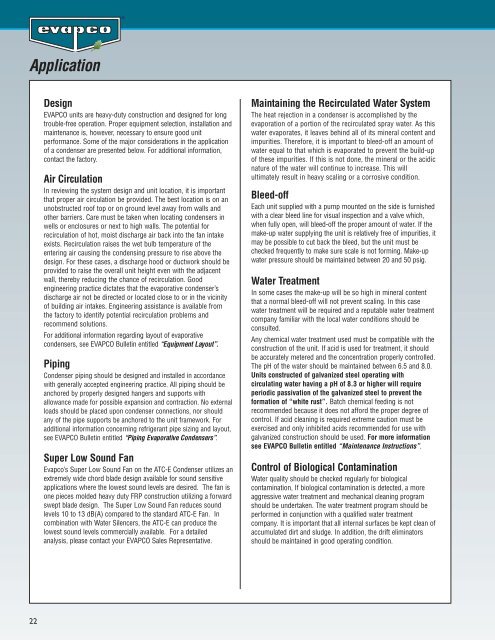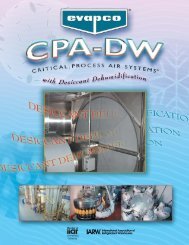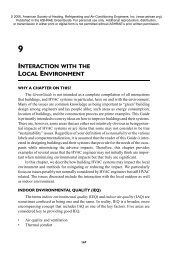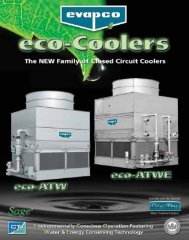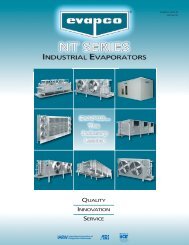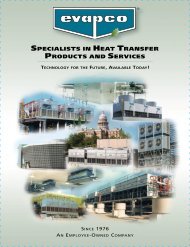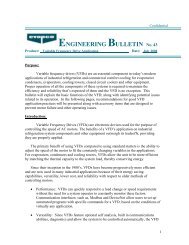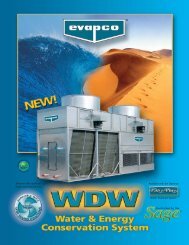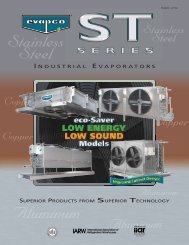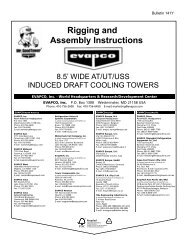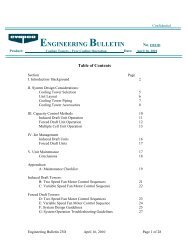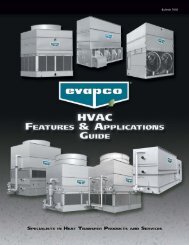PMC-E Product Brochure - EVAPCO.com
PMC-E Product Brochure - EVAPCO.com
PMC-E Product Brochure - EVAPCO.com
You also want an ePaper? Increase the reach of your titles
YUMPU automatically turns print PDFs into web optimized ePapers that Google loves.
Application<br />
22<br />
Design<br />
<strong>EVAPCO</strong> units are heavy-duty construction and designed for long<br />
trouble-free operation. Proper equipment selection, installation and<br />
maintenance is, however, necessary to ensure good unit<br />
performance. Some of the major considerations in the application<br />
of a condenser are presented below. For additional information,<br />
contact the factory.<br />
Air Circulation<br />
In reviewing the system design and unit location, it is important<br />
that proper air circulation be provided. The best location is on an<br />
unobstructed roof top or on ground level away from walls and<br />
other barriers. Care must be taken when locating condensers in<br />
wells or enclosures or next to high walls. The potential for<br />
recirculation of hot, moist discharge air back into the fan intake<br />
exists. Recirculation raises the wet bulb temperature of the<br />
entering air causing the condensing pressure to rise above the<br />
design. For these cases, a discharge hood or ductwork should be<br />
provided to raise the overall unit height even with the adjacent<br />
wall, thereby reducing the chance of recirculation. Good<br />
engineering practice dictates that the evaporative condenser’s<br />
discharge air not be directed or located close to or in the vicinity<br />
of building air intakes. Engineering assistance is available from<br />
the factory to identify potential recirculation problems and<br />
re<strong>com</strong>mend solutions.<br />
For additional information regarding layout of evaporative<br />
condensers, see <strong>EVAPCO</strong> Bulletin entitled “Equipment Layout”.<br />
Piping<br />
Condenser piping should be designed and installed in accordance<br />
with generally accepted engineering practice. All piping should be<br />
anchored by properly designed hangers and supports with<br />
allowance made for possible expansion and contraction. No external<br />
loads should be placed upon condenser connections, nor should<br />
any of the pipe supports be anchored to the unit framework. For<br />
additional information concerning refrigerant pipe sizing and layout,<br />
see <strong>EVAPCO</strong> Bulletin entitled “Piping Evaporative Condensers”.<br />
Super Low Sound Fan<br />
Evapco’s Super Low Sound Fan on the ATC-E Condenser utilizes an<br />
extremely wide chord blade design available for sound sensitive<br />
applications where the lowest sound levels are desired. The fan is<br />
one pieces molded heavy duty FRP construction utilizing a forward<br />
swept blade design. The Super Low Sound Fan reduces sound<br />
levels 10 to 13 dB(A) <strong>com</strong>pared to the standard ATC-E Fan. In<br />
<strong>com</strong>bination with Water Silencers, the ATC-E can produce the<br />
lowest sound levels <strong>com</strong>mercially available. For a detailed<br />
analysis, please contact your <strong>EVAPCO</strong> Sales Representative.<br />
Maintaining the Recirculated Water System<br />
The heat rejection in a condenser is ac<strong>com</strong>plished by the<br />
evaporation of a portion of the recirculated spray water. As this<br />
water evaporates, it leaves behind all of its mineral content and<br />
impurities. Therefore, it is important to bleed-off an amount of<br />
water equal to that which is evaporated to prevent the build-up<br />
of these impurities. If this is not done, the mineral or the acidic<br />
nature of the water will continue to increase. This will<br />
ultimately result in heavy scaling or a corrosive condition.<br />
Bleed-off<br />
Each unit supplied with a pump mounted on the side is furnished<br />
with a clear bleed line for visual inspection and a valve which,<br />
when fully open, will bleed-off the proper amount of water. If the<br />
make-up water supplying the unit is relatively free of impurities, it<br />
may be possible to cut back the bleed, but the unit must be<br />
checked frequently to make sure scale is not forming. Make-up<br />
water pressure should be maintained between 20 and 50 psig.<br />
Water Treatment<br />
In some cases the make-up will be so high in mineral content<br />
that a normal bleed-off will not prevent scaling. In this case<br />
water treatment will be required and a reputable water treatment<br />
<strong>com</strong>pany familiar with the local water conditions should be<br />
consulted.<br />
Any chemical water treatment used must be <strong>com</strong>patible with the<br />
construction of the unit. If acid is used for treatment, it should<br />
be accurately metered and the concentration properly controlled.<br />
The pH of the water should be maintained between 6.5 and 8.0.<br />
Units constructed of galvanized steel operating with<br />
circulating water having a pH of 8.3 or higher will require<br />
periodic passivation of the galvanized steel to prevent the<br />
formation of “white rust”. Batch chemical feeding is not<br />
re<strong>com</strong>mended because it does not afford the proper degree of<br />
control. If acid cleaning is required extreme caution must be<br />
exercised and only inhibited acids re<strong>com</strong>mended for use with<br />
galvanized construction should be used. For more information<br />
see <strong>EVAPCO</strong> Bulletin entitled “Maintenance Instructions”.<br />
Control of Biological Contamination<br />
Water quality should be checked regularly for biological<br />
contamination, If biological contamination is detected, a more<br />
aggressive water treatment and mechanical cleaning program<br />
should be undertaken. The water treatment program should be<br />
performed in conjunction with a qualified water treatment<br />
<strong>com</strong>pany. It is important that all internal surfaces be kept clean of<br />
accumulated dirt and sludge. In addition, the drift eliminators<br />
should be maintained in good operating condition.


